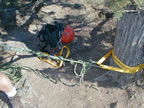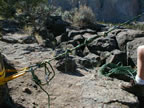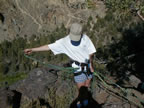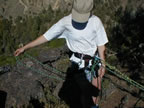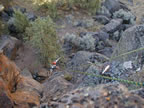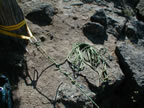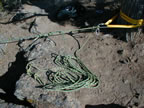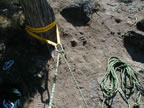 |
Jim Frankenfield jim@mountain-guiding.com; 1-877-604-0166 Mountain Guiding; Mountain Safety |
![]()
Guiding NewsletterJune 2001 - Tech Tip SupplementAssisted Rappel/Lower
Technique Tip(s) Imagine yourself in a variation of the above Wy'East route attempt. You're leading a couple of climbers who are all relatively inexperienced, perhaps for a club. You've reached a ridgeline but are running so late and moving so slow that continuing seems unsafe. You can abort the climb and return safely if you can descend about 250 feet. Before it warms up too much more, or before that storm moves in. One way to do this, assuming you have two ropes in your party, is to set up an assisted rappel/lower to get the less experienced members of the team down quickly. The leader will then have to follow in some other manner. By tying two ropes together you have the potential to descend up to 300 ft or so. One rope (the rappel rope) is used for the climber to rappel on. The other rope (the belay/lowering rope) is used by the leader, intially to belay the rappel and then to lower an additional rope length. The rappel rope must be shorter than the other one used to belay, so it is tied into the rappelling climbers harness both at the end and again about 6-10 ft from the end. (If the rappel rope is not shortened enough the belay may become weighted.) It helps to know the relative lengths of the ropes - be familiar with your equipment before you go out climbing. The rope is attached to the anchor system on the belay/lowering rope just above the knot joining the two ropes (often a double-fishermans or a variation of one). By attaching the rope to the anchor system with a Munter hitch it can be used for lowering later, but initially the Munter hitch needs to be secured with a Mule knot (or equivalent). The rappelling climber now sets up on the rappel rope just below the knot joining the two ropes. The end of the belay/lowering rope is attached to their harness independently and used as a belay. When the rappelling climber reaches the end of the rappel rope (or the knot which they also tied into 6-10' before the end) they unclip the belay rope. The leader now pulls this back up to the anchors and stacks it ready to feed out for lowering. The leader can now unblock the Munter hitch and lower the other climber an additional ropelength using the belay/rappel rope. There are a few things to note about this system:
|
|||||||||||||||
![]()
Guiding Newsletter Archive |
Climbing page |
